Home
Up
Axiom Guitars
Axiom2
Plug&Play Pickups
U Boat 47
Headphones & Monitors
Sound Samples
Accessories
Guitars
Guitar Custom Shop
Product Development
Demo Videos
Press
About / Contact
Artists
Orders
New Tools
KAM on Facebook
Warranty
|
|

|
|
Studio Condenser and
Ribbon Mics
| Candy: Phantom Powered Ribbon
Mic
How
many ribbon mics do you know of that can capture frequencies
up to 20 kHz?
Candy
demonstrations at NAMM received overwhelming praise from
audio engineers. It is an entirely new animal with its own
signature sound. It produces warm and detailed vocals
especially suited for male vocalists.
Applying candy to any sound source produces results
that are different from the norm.
Candy
is a Phantom Powered modern Ribbon Mic with a magnet
structure optimized for amplified ribbon capture approach.
It is designed to have the tone of vintage ribbon mics but
also cover an extended high frequency range. The addition of
internal amplifier removed the design restrictions of
classic ribbon mics which were trade-offs between output
volume and frequency response.
Candy’s
frequency response can be considered in two ranges;
1)
Normal ribbon range: It produces
the classic response curve of a dynamic ribbon mic, dropping
the highs as they get close to 15kHz. This is
responsible for the warm characteristic ribbon tone.
2)
Extended
high frequency: Due to the special magnet design, the
response curve picks up after 15 KHz and goes all the way up
to 20KHz.
The
casing is rugged to protect the ribbon element and the
capsule section is completely separate from the lower body
portion to prevent sound reflections inside the casing from
interfering with the purity of the output.
Due
to internal phantom powered amplifier, it produces high
output similar to a condenser mic and is as easy to use in a
studio as a normal condenser. This feature eliminates the
need for recording at high pre-amp gain settings which
normally lead to higher noise level. The -10db Pad and Bass
roll-off switches allow adapting the mic to characters of
the sound source.
Included
accessories: KAM PF-1 micro metal mesh pop filter, Foam pop
filter, Shock mount, Aluminum storage case, Soft carrying
pouch.
Applications:
Candy
differs from classical ribbon mics and the extended
frequency response allows application to almost any sound
source for producing unique and colorful results :
 |
1-
Sound
sources that benefit from natural warmness of ribbons in
mid frequencies such as vocals, strings, acoustic
guitars and guitar cabinets.
|
 |
2-
Stereo
pair recordings: The
figure 8 pickup pattern allows unusual stereo separation
when two mics are placed at an angle with respect to
each other. Unique results can be obtained from drum
overhead and room Mic applications.
|
 |
3-
Instruments
with low frequency sounds such as Bass drums and bass
cabinets, or to accent the low-end of guitar cabinets.
|
 |
4-
Sound
sources that need taming of harsh high-mids such as
brass instruments and overly high-mid heavy amps.
|
(Note:
For sources which produce high velocity air movement, such
as bass drums and amp cabinets, the provided foam wind
screen should be used to protect the ribbon.)
 |
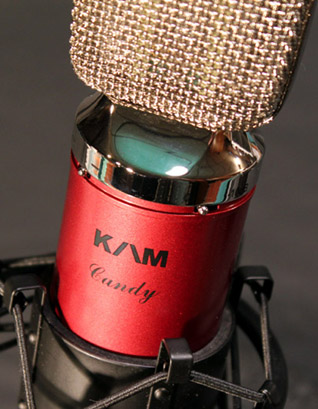
K/\M Candy

Specifications:
Ribbon
material: Pure Aluminum foil, 2 micron thickness
Frequency
response: 20 to 20 KHz
Pattern:
Figure 8
Impedance:
200 ohms
Max
SPL 130 dB - 140 dB with pad switch engaged (1% THD at 1
KHz)
Self
noise: < 15 dB - A weighted
Sensitivity:
-34 dB
Power
requirement: 48 v Phantom power
S/N
Ratio: 79 dB
Pad
Switch: -10dB
Bass
roll off switch: 12 dB/octave 80 Hz
MSRP:
$390 |
|

K/\M 2face
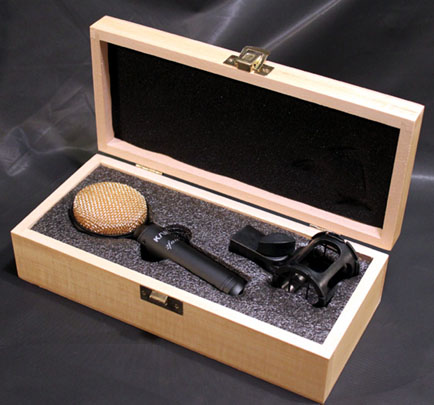
|
2face: Two sided Condenser /
Ribbon simulator
2face
offers very unique capabilities and extreme ease-of-use in
the studio. The capsule used in 2face has an asymmetrical
figure 8 pickup pattern. When using the back side, the
pickup pattern combined with proximity effect (when
recording close-up vocals) produces very warm recordings
that sound very much like ribbon mics. However, since both
sides of the mic are always active, when using the back
side, there is more room sound being recorded than with
ordinary mics, which contributes to creating unique spacious
recordings with 2face. Demonstrations of 2face mics at
Summer NAMM, with turning the face for the two tones were
very surprising to most audio engineers.
 |
It
has never been easier to test your sound source with two
different capsule/or microphone tones. Just turn the
microphone 180 degrees !
|
 |
It
offers the simulated ribbon tone with high output and
low noise (< 14dB A) associated with a condenser
design.
|
 |
It
is durable, not fragile as ribbon mics. High velocity
air flow, very loud sources, or moderate shock will not
harm 2face.
|
 |
The
Condenser face (front side) is a large diaphragm capsule
with very detailed, linear, and clear sound appropriate
for male and female vocals, acoustic guitars, strings,
piano, drum overheads, and many other sound sources.
|
 |
The
back side (ribbon simulator) is appropriate for male
vocals, guitar cabinets, horns, any sources with harsh
mid range frequencies.
|
Included
accessories: Wooden storage box, Mini shock mount
Specifications:
Capsule
size: 36mm, 1and 7/16 inch
Frequency
response: 20 to 20 kHz
Pattern:
Asymmetrical Figure 8
Impedance:
100 ohms
Recommended
load Impedance: > 1000 ohms
Max
SPL 130 dB (1%
THD at 1 kHz)
Self
noise: < 14 dB - A weighted
Sensitivity:
-34 dB
Power
requirement: 48 v Phantom power
S/N
Ratio: 80 dB
MSRP
Price: $180

|
| Crystal: High output Condenser
Surface
Mount Technology (SMT), transformer-less design, and large
34mm capsule contribute to exceptional clarity of recordings
produced by Crystal. The electronic circuit has been
designed to produce higher than normal output level as well
as linear response. In comparison with majority of Condenser mics, Crystal produces as much as 6 dB higher output. As a
result, lower preamp gain is required which leads to lower
preamp noise.
The
34mm capsule produces full sounding lows without emphasis on
any particular frequencies, while the small form factor
allows flexibility in placement.
Crystal
is suitable for vocals, acoustic guitars, drum overheads,
and a wide range of other applications.
Advantages
of Surface Mount Technology (SMT)
 | Better
high frequency performance due to lower resistance and
inductance at soldering points |
 | Higher
mechanical resistance to vibration and shock |
 | Reduced
possibility of RF interference |
 | Allows
robust designs with high number of components in a small
form factor |
Crystal
Specifications
Capsule:
34mm Gold Splattered
Max
SPL: 125 dB (0.5% THD)
Polar
Pattern: Cardioid
Frequency
Response: 20 Hz to 20 kHz
Sensitivity:
-38 dB
Impedance:
200 Ohms
Self-Noise:
< 20 dB
Power
Requirement: 48V Phantom Power
Weight:
240g
Dimensions:
Max Diameter :53mm, Height:132mm
MSRP: $149 |
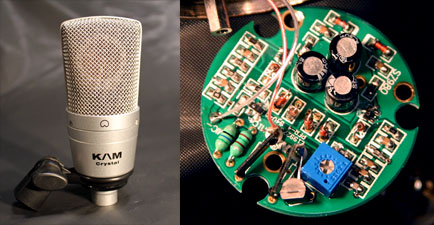
KAM Crystal
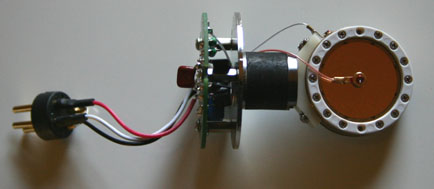

|
|
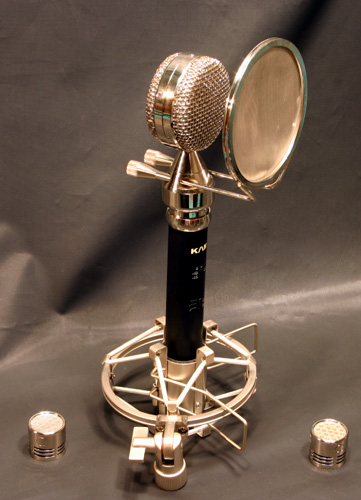
K/\M MC3
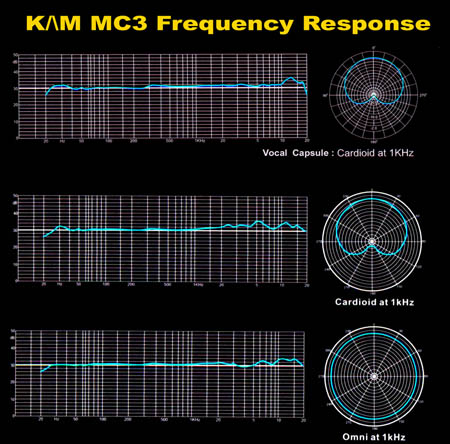
Response for Cardioid and
Omni capsules are over 0 dB line even at 20 KHz ! |
MC3: Multi-Capsule Condenser
MC3 represents a new concept in studio mics. It is an extremely
versatile mic with very unique capabilities. It comes with
three interchangeable capsules;
The vocal capsule comes with a self contained micro screen
metal mesh pop filter. While ordinary nylon pop filters
absorb about 2 to 3db of high frequency content of the
sound, the micro metal mesh is completely transparent, yet
even more effective than nylon filters. This condenser
capsule is 1 and 1/4 inch in diameter with a one inch diameter
diaphragm. It is identical to the
one in our C3 condenser mic. But the sounds are
slightly different since the electronic circuit in MC3 is
designed for lively and animated recordings.
The Omni directional capsule is specially designed to
convey "presence" in the sound. It can
produce unusually detailed recordings and is ideal for use as
instrument mic (eg. acoustic guitars or piano), overhead drum mic,
room mic, or for orchestral recordings.
The cardioid capsule is tailored for percussive sources
and with a slight mid boost, adds an extra "
punch" to recordings. It shines for applications
such as snare drum, hand percussions, or situations where a
tight pickup pattern is required.
 | Overall frequency response: 20Hz to 20KHz |
 | Bass roll of switch (-10 dB& @ 75 Hz or 100
Hz), |
 | Attenuation (pad) switch (-10 or –15 dB) |
 | Max SPL: 120 dB at 0.5% THD |
 | Equivalent self noise: <22 dB |
 | Impedance: 200 Ohms |
 | Requires
48 volt phantom power |
 | Comes with a shock mount and case, with room to
store all
the accessories. |
MSRP: $269

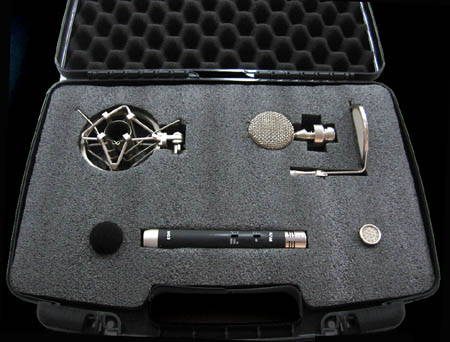
|
| R3: Studio Ribbon Mic
A ribbon mic with unusually warm and natural sound.
Have you ever wondered why vocals from the 50s sounded
so sweet? Have you tried analog tape and mixers with tons of
EQ and still just got only close to that sound? Ribbon mics
where the essential ingredient of that sound.
Ribbon mics have a sound quality
unmatched by any other technology. In a normal dynamic mic, a
diaphragm which vibrates with sound is attached to a coil
that generates the signal by vibrating in a magnetic field.
In Ribbon mics, an aluminum ribbon both vibrates to sound
and generates the signal since it is positioned in a strong
magnetic field. So the sound is extremely pristine. The
highs are also naturally rolled back in a way that is very
difficult to reproduce by EQing, because the "roll
back" ratio is variable based on frequency and
intensity of
sound.
R3 produces very pleasant vocal tracks. You can boost the
highs to get more presence, and the warmness still remains
in the sound because it is mostly due to superb reproduction of mid range
frequencies which human vocal cords produce.
Another application for R3 is guitar cabinets. Many mics
produce harsh highs and just don't express the sweetness of
a tube amp that is heard live. With Maximum SPL of 165
DB, R3 can be your best friend in the studio to capture the
warmth of a tube amp.
MSRP: $219

Comes with wooden
protective box and shock mount.
|
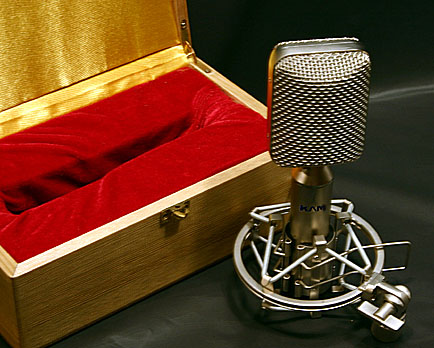
K/\M R3
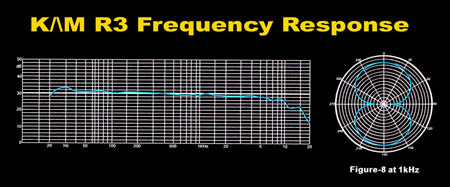
|
|
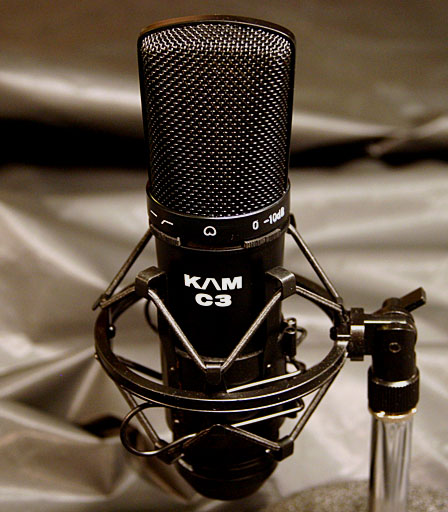
K/\M C3
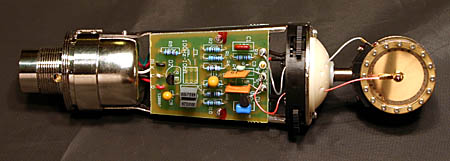
|
C3:
Large Diaphragm Condenser
When
we test prototype of our mics, we have a special target sound
in mind. Sometimes we get very close to it, and sometimes we
run into characteristics that were unforeseen, but definitely
worth offering to sound engineers. While
we don't claim to have found the holy grail, C3 is very
close to it!
Many
condenser mics suffer from uneven frequency response
which leads to sound coloration. C3 only deviates from an
almost flat response curve between 20Hz and 20 KHz by about
+3.5 dB. Furthermore, that deviation is exactly at the right
place; over 10 KHz. The reason why this is a “good”
deviation is that nylon pop filters absorb about 2.5 dB of
high frequency over 10 KHz. So when recording vocals with
nylon pop filters, the C3 response curve is almost completely
flat. Traditionally, studios have spent several thousand
dollars on mics with this type of response curve.
The
pad and bass roll-off switches add flexibility to applications
of C3. It can be used on any sound source with excellent
results. Including, acoustic instruments, guitar and bass
cabinets, and percussion instruments. Toms sound larger than
life and extremely crisp with C3. When used without a pop
filter, C3 has a slightly exaggerated high frequency which
adds to the crispness of the sound.
Internally,
the mic features a 1 and 1/4 inch capsule, with a 1 inch gold
covered diaphragm.
MSRP:
$195

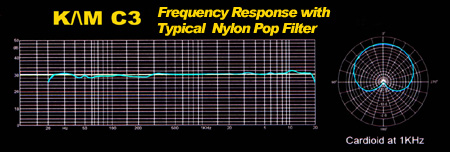
|
All
specifications and pricing are subject to change without notice.
|
|